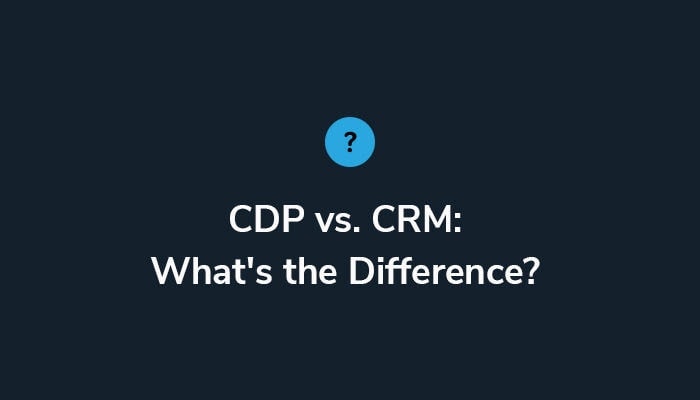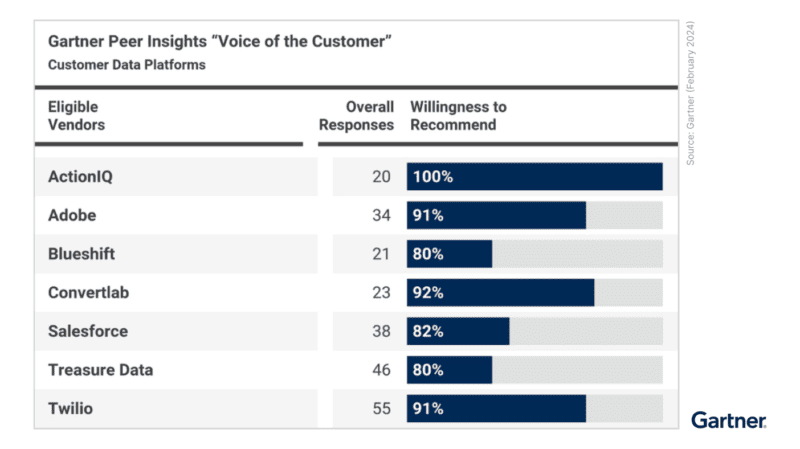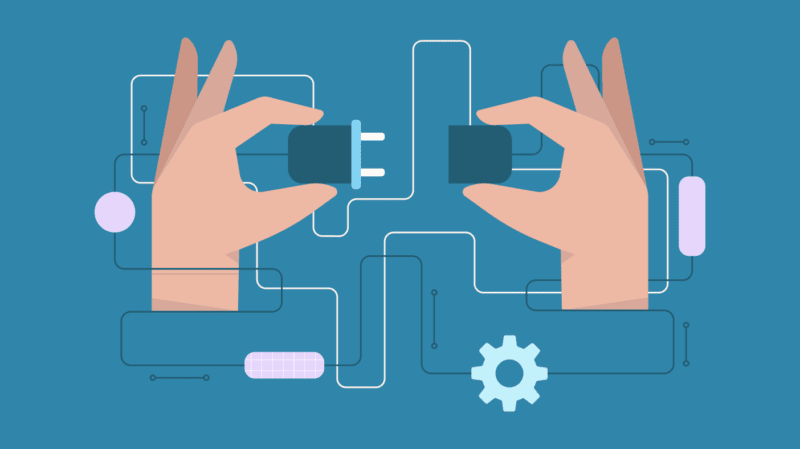CDP vs CRM: What’s the Difference?

It’s estimated that the average consumer receives upwards of 4,000 marketing messages a day. In such an environment, the modern marketer must cut through all that noise by personalizing customer interactions, ideally through marketing automation. While personalization can take countless forms, it essentially comes down to two things:
- Recognizing customers at every touchpoint of the marketing campaign, understanding the breadth of their relationship with your brand and speaking to them with one voice.
- Using all relevant customer behavior data gathered over the course of that relationship to ensure messages have a high probability of being helpful, enticing or otherwise relevant.
Beginning in the 1990s, customer relationship management systems (CRM platforms) became the principal martech tool for personalization. This new brand of marketing technology was architected to track and manage every interaction the brand had with customers and prospects. Over the years, CRM also began to incorporate analytical tools that drew on those interactions to help drive retention and customer lifetime value (CLTV).
By the 2000s and especially the early 2010s, the proliferation of digital touchpoints, from mobile apps to social media, overwhelmed CRM’s data and analytical capabilities. This was especially challenging for brands that had adopted best-of-breed CRM and other customer-facing solutions, rather than going all-in with a single vendor. And so the disconnect between disparate customer data sources, execution systems, and marketing teams widened. While personalization across channels was possible, it was a complex, expensive, IT-dependent process.
And so, in the mid-2010s, customer data management gurus began to work out a new, entirely system-agnostic and flexible approach to unifying data from disparate systems, both historic and real-time. But they realized this was not enough. Too often valuable insights from the third-party data sat in the marketing cloud unused because of the difficulty of pushing those insights out to disparate channels in an orchestrated way. So these data gurus also forged ways to seamlessly connect all that data into customer modeling—and all the insights it could produce—to channel execution systems.
And through an evolution of customer relationship management and data management platforms, the customer data platform (CDP) was born.
As Dom Nicastro writes in CMS Wire, CRM and CDP solutions are “both important enterprise technologies, and while there is some overlap they have very different functions.”
In other words, no brand can simply choose between a CDP and a CRM system. Instead, each must define its own personalization strategy for the digital age. Then it must identify specific use cases to support strategies that deliver personalized experiences. And finally, the brand must evaluate its current marketing and sales technologies, identify gaps, and determine if a CDP is required to close those gaps.
The massive projected growth in the CDP market—expected to go from $2.4 billion in 2020 to $10.3 billion by 2025—indicates that brands are rapidly embracing this marketing technology to enhance the value of traditional CRM technologies with the ability to personalize experiences at scale.
To understand the potential uses of CRMs and CDPs for your marketing team and within your organization, keep reading to discover:
- The expanding mission of CRMs in the digital age and why CRM systems need insights fueled by outside data sources from the CRM ecosystem.
- Clear definitions of CDPs and CRM technologies, and how one can enhance the value of the other.
- How brands are already benefiting from CDP-enhanced CRMs.
What is a CDP and How is it Different From a CRM Tool?
Before we explore how CDPs and CRM systems can work together to help fulfill the expanding marketing, segmentation and sales function of CRM, let’s define what we mean by “CRM” and “CDP” in the first place.
What is CRM?
Here is how Gartner defines CRM tools: “Technologies [that] enable strategy, and identify and manage customer relationships, in person or virtually. CRM software provides functionality to companies in four segments: sales, marketing, customer service and digital commerce.”
In simple terms, a CRM platform is built to engage effectively with customers, and can encompass all kinds of channels, from call centers to social media and mobile apps. They also gather behavioral and other customer data to create a persistent customer profile.
CRM solutions provide customer-facing employees—call center employees, sales teams and point of sale associates—with a user-friendly interface to quickly and effectively view, update or add customer profiles.
And while they can provide a certain level of analytical insight to these users, they do lack the following:
- Storage of historical clickstream, purchase or marketing data
- Predictive analytics models
- Identity resolution
- Storage of anonymous cookies
- Customer journey design and automation
- Prebuilt APIs to other marketing, CX or communications apps.
What is a Customer Data Platform?
What is a CDP? Unlike CRM systems, a true CDP vendor will design their platform from the ground up to gather and unify all kinds of customer data sources, thanks to prebuilt connectors that can ingest streaming, real-time and batch integrations from any data source. And unlike CRM systems, CDPs are engineered to process vast amounts of data at extreme speed. As a marketing system, it enables marketers to model customer profiles and optimize the timing and targeting of marketing communications.
With this combination of flexibility and speed, CDPs systems can build a much more comprehensive view and assist in creating a unified customer profile, including data from:
- Best-of-breed or legacy CRM solutions not in your larger CRM suite
- Data warehouses and data lakes
- Transactional and other data from internal sources
- Data from other third-party sources
- Both structured and unstructured data
- Both batch and streaming data.
As we said in the introduction, a customer data platform offers a more holistic view of customers than CRM tools can. Even the large CRM titans like Salesforce are entering the customer data platform field in hope of further improving customer engagement and loyalty through their CRM expertise. And CDPs also empower marketers to quickly and intelligently activate that data without waiting on IT, thanks to the following combination of capabilities:
- Customer matching: Besides ingesting raw data from any source, CDPs automatically organize and match granular data points to a single customer record.
- Centralized decisioning (both automated and human-driven): All that unified, granular customer data can fuel powerful insights from AI, machine learning and other predictive analytics. Just as important, marketers can have self-service access to that data and combine attributes on the fly to create highly targeted segments in minutes.
- Seamless execution across all channels execution: CDPs can connect to any CRM application or other marketing execution system. As a result, you can instantly orchestrate customer interactions across any marketing channel. Best-in-class CDPs can even automate optimization of content, timing and channel(s) based on individual customers’ unique data.
How do CDPs and CRM Gather and Manage Data?
Although CDPs and CRMs serve different, yet similar purposes, they both still act as a marketing system that collects data, such as first-party data.
- CDPs gather data through an automated process. Designed to help non-customer facing roles like marketing, product and sales; the data CDPs collect is usually automatically gathered using integrations and code snippets. As a multiple source system, customer data can be gathered online and offline, allowing the unified data to be cleansed, deduplicated and normalized.
- CRM gathers data through a manual process. Designed for customer-facing roles, such as a salesperson, it responded to the need for a centralized account of direct interactions between the existing customer and representatives of the business. Since CRM data is manually gathered the data collected is hard to export and hard to automate.
As a side note, CDPs are similar to a traditional data management platform (DMP), as they both collect structured and unstructured data from online and offline data sources. However, CDPs use personally identifiable information (PII), like identity data. DMPs are used for anonymous data.
Doubling Down on Customer Loyalty with CRM
We are entering an age in which a CRM solution is ever-more important to the bottom line. Here’s why. On one hand, customer acquisition costs (CAC) are rising fast. Yet it is becoming harder and harder to convert potential customers into loyal ones.
In the past, brands could count on the fact that, almost by default, a certain percentage of new customers would become repeat customers. And then a certain percentage of those the known customer segment would become loyal ones. That is simply not the case when consumers are just a click away from such a wide range of competitive offerings. The result: downward pressure on average customer lifetime value.
According to one recent survey, almost 7 out of 10 global consumers are willing to abandon brands if they deliver disconnected customer experiences. The good news is that, for brands that get it right, customer loyalty is not dead. For example, it has long been assumed that millennials were particularly fickle consumers, but a 2018 study found they were becoming more loyal, not less loyal, customers. However, that loyalty is definitely not a one-and-done deal. Brands have to earn it with each customer interaction. And that is where CRM comes in.
To help close the gap between rising CAC and stagnant or falling CLTV, brands across industries have embraced CRM to deliver the kinds of relevant customer interactions that drive loyalty and, ultimately, lifetime value.
“Doing CRM well is largely about retention,” says Matt Mikulski, VP of CRM at Theory. “If you can keep a customer engaged with the right marketing interactions, as well as with associates and your website, they’re going to keep coming back time and time again.”
In fact, many brands are reallocating resources from brand marketing to CRM initiatives.
“Brands today are connecting to their users more and more via CRM than with the big, splashy brand campaigns of the Mad Men era,” says Stephanie Austin, director of CRM Marketing at Pandora.
But More Data Points Needed…
While CRM systems can deliver the experiences that keep customers coming back, you need as much customer data as possible to make those experiences relevant. However, CRM systems on their own are generally limited to CRM data from within the solution itself. They lack the speed and scale to combine with outside data sources. This limits personalization efforts in a number of ways:
- Disconnected experiences: When one channel lacks insight into interactions from other channels and systems, you end up sending disconnected or irrelevant messages (i.e. ads for a product already purchased).
- Oversaturation: When campaigns are channel-specific, you risk overwhelming certain customers—often your best customers—by sending too many potentially irrelevant messages.
- Shallow personalization: Without a single view of the customer across all touchpoints, you are often limited to retargeting practices based on only a single isolated action, like one web page browsed or one ad clicked.
On the other hand, you can create much more relevant messages when you’re able to combine data from across currently siloed data sources, such as web pages a customer has browsed combined with her historic transactions and insight into her price sensitivity. With all that precise, granular insight into an individual customer’s intent and preferences, marketers can “show users you can add value to their lives by surfacing relevant content, relevant ads and relevant emails that make them want to keep coming back,” Austin said.
In short, modern CRM-driven marketing requires the ability to break down channel-specific data silos to create a holistic single customer view that draws on historical behavior of your unique customer base—including predictive insights from AI and/or machine learning.
First-Party Data Plus CRM Can Drive Acquisition Now, Too
To understand the power of CRM systems fueled by first-party behavioral data, consider that innovative brands are actually using this combination for customer acquisition, not just loyalty and retention.
It sounds impossible: How do you use data to attract a consumer before she ever makes a purchase? The fact is, brands are collecting potentially valuable pre-purchase first-party data these days, such as emails. And that is enabling CRM marketers to personalize experiences even during the awareness stage of the customer lifecycle.
“Because we have a lot more data today about customers still in the awareness stage, we can start to implement CRM-driven messaging much earlier in the purchase process, rather than waiting to respond until after a transaction is completed,” Mikulski said.
At the same time, brands that have a single customer view, including both real time and historic behavioral data, can enhance their return on investment in brand marketing such as paid advertising. For example, they can:
1) Stop wasting ad dollars by suppressing existing customers from brand campaigns.
Not only do you stop wasting ad spend, you also avoid saturating good customers with irrelevant messages.
2) Identify and target prospects that share key characteristics of your best customers. With a simple recency/frequency/monetary value (RFM) model, you can identify your best customers and then use them as a seed audience on your advertising platform, which can then automatically find others like them via built-in lookalike modeling.
3) Stop targeting prospects that share key characteristics with your least valuable customers (i.e., one-time buyers). Much as you do with your best customers, you can identify one-time-only purchasers and use lookalike modeling to avoid wasting valuable ad dollars messaging consumers that are likely to respond in similar ways.
4) Optimize the content you deliver with affinity models that draw on past behaviors. When your active customers appear on third-party sites, you can increase response rates by delivering messages that most align with their past content preferences, as indicated by browser and clicks.
How Brands Are Successfully Combining CRMs with CDPs
We’ve talked about the challenges businesses face in driving loyalty in the digital age. However, let’s consider how one $5 billion retailer successfully delivered double-digit growth by supercharging its CRM systems and its marketing efforts with the ActionIQ CDP.
Specifically, the retailer was able to build tighter integration between its acquisition and retention programs. In addition, marketers could personalize experiences much earlier in the lifecycle and therefore improve customer engagement. Finally, the brand used the CDP to power a successful relaunch of its customer loyalty programs.
Here are just some of the measurable results the brand achieved:
- 1000x more data leveraged for customer intelligence and personalization
- 100% of new campaigns orchestrated across multiple channels
- 75% reduction in time to market for new marketing ideas
- 10x more models leveraged as part of marketing campaigns
- 90% reduction in the level of effort demanded of IT
“ActionIQ has become the central hub for creating personalized brand experiences delivered in real-time across our digital and offline channels to empower business users,” said the brand’s vice president of data and platforms.





